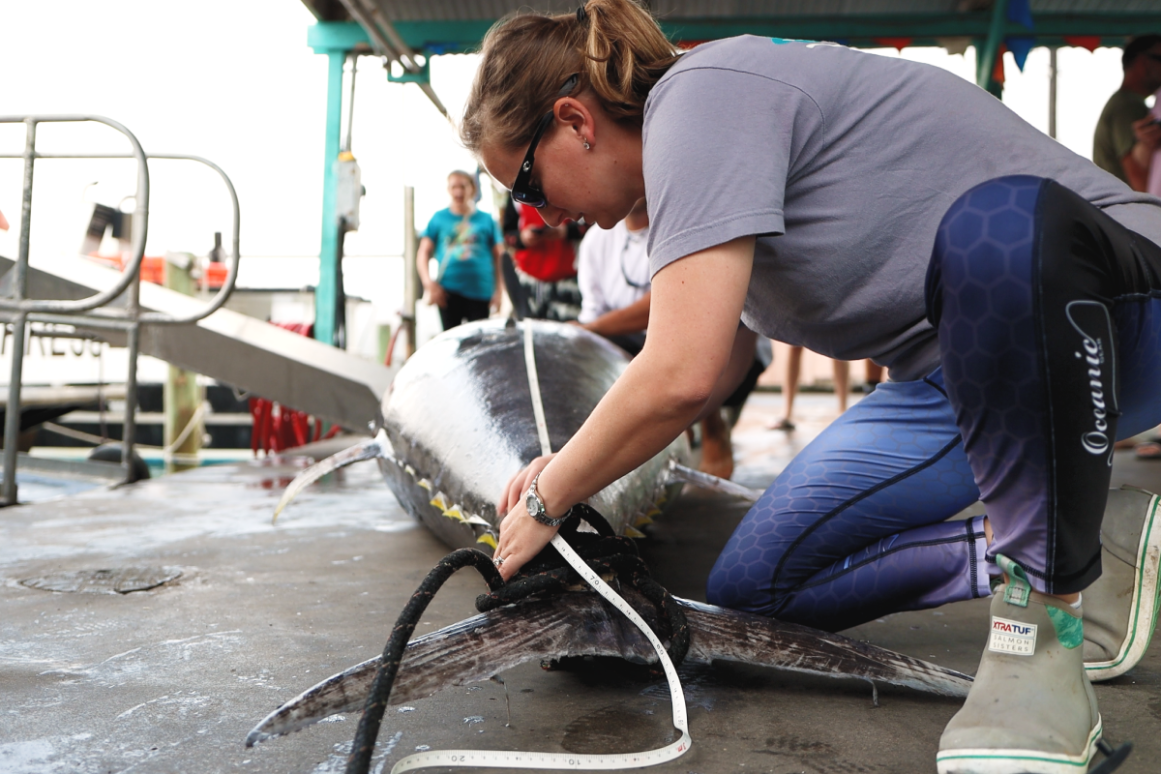Just One Call — Sportfish Center Researchers Partner with Anglers to Sample Rare Catch

CORPUS CHRISTI, Texas — The catch of the lifetime can mean more than just a good fish tale. It just takes one phone call — and some scientists waiting on the other end of the line — to make your record catch contribute to a body of research that can ensure its sustainability for many lifetimes to come.
Scientists with the Center for Sportfish Science and Conservation, located at the Harte Research institute for Gulf of Mexico Studies (HRI) at Texas A&M University-Corpus Christi, have formed a unique relationship with local docks, charter captains, and anglers in the Coastal Bend area. For several weeks in the spring, HRI sportfish researchers are on-call for science — and when a rare species is caught, such as the bluefin tuna, they pack up and run to take samples for their work and the work of scientists around the Gulf.
“These fish are a real treasure and very rare, with only 4-6 per year caught and retained,” said Sportfish Center Director Dr. Greg Stunz. “Working with anglers allows us to get samples from these fish that would otherwise not be possible.”
Atlantic bluefin tuna are a migratory species that are highly-regulated under a rebuilding plan that allows extremely limited harvest by fishermen. Only a handful are allowed to be taken in season each year, depending on weight, under current quotas in the Gulf of Mexico. That means the opportunity to sample and study these fish and learn about their lives in the ocean is an incredibly rare opportunity for scientists.
So far this year, researchers at the Sportfish Center have taken samples from two fish caught out of Port Aransas, Texas: A state record 19-year-old, 876-pound bluefin tuna brought into Fisherman’s Wharf and a 23-year-old, 706-pound bluefin tuna caught aboard the Dolphin Express out of Dolphin Docks.
To get an idea of just how rare an opportunity this is, Tim Oestrich, captain of the Dolphin Express, who helped to bring in the 23-year-old fish, said he’s been fishing his whole life, and this was the first bluefin tuna he’d ever landed on an excursion.
“We only have a window of about 3-4 weeks, and the weather’s got to line up and the people have to line up,” he said.
The process all starts with a phone call from an angler or someone working at the local docks, said Dr. Kesley Banks, a postdoctoral research associate with the Sportfish Center who has conducted many of the sampling trips. Anglers alert the researchers to the catch of a bluefin, and from there someone on the team will drop everything and go.
“For the potential state record bluefin tuna, I got the call at midnight,” Banks said. “Thankfully we were able to delay it until the morning when they were planning to clean it. But for these few weeks if we get the call — somebody has to just go. We have a bag of equipment packed and ready to grab and take out the door.”
At the docks, once the fish has been offloaded, researchers have a conversation with the angler to let them know what they’d like to sample from the fish and how that material will be used in research work. After getting permission to take samples from the fish, the fish is cleaned and the work begins.
The Sportfish Center researchers remove the otoliths — ear bones — from the fish, which can be used to age the fish. In their lab at HRI, these researchers set the otoliths in resin and then take a cutting so they can count the lines in the bones like rings on a tree to determine how many years the fish has been alive.
Other samples are taken that will be shared, spreading the influence of a single fish Gulf-wide. Since bluefin are so rare, Banks said, many researchers have standing requests with the Sportfish Center. Vertebrae are taken to conduct chemistry work on the fish and learn about its life in the ocean. They also take a sample of the fish’s muscle tissue to learn more about what it might be eating, and study the heavy metal content — large pelagic fish are known to contain high levels of mercury, for example. Fin clips are taken develop a genetic profile of the fish.
Taylor Garcia, director of operations at Fisherman's Wharf in Port Aransas, said partnering with the Sportfish Center researchers was a natural fit. The wharf gives the Sportfish Center access to larger boats, experienced fishing captains, rare catches, and a lot more people fishing. The anglers at Fisherman’s Wharf are excited to interact with marine biologists, and to learn about fisheries science and conservation opportunities because they want to support the continued health and longevity of the sport they love.
The marina has hosted numerous shark-tagging expeditions with the Sportfish Center team on their boats, and even run workshops with its employees to learn more about better catch-and-release techniques. It’s a partnership both sides hope to continue into the future.
“If we can provide access to these rare fish that are already caught, and make the angler care a little bit more in the process — that’s a great thing,” Garcia said. “We’re just trying to do our part and pursue conservation where we can, because we rely on the sustainability of the fishery to keep this business going.”
“We want to keep on fishing,” Garcia added.
